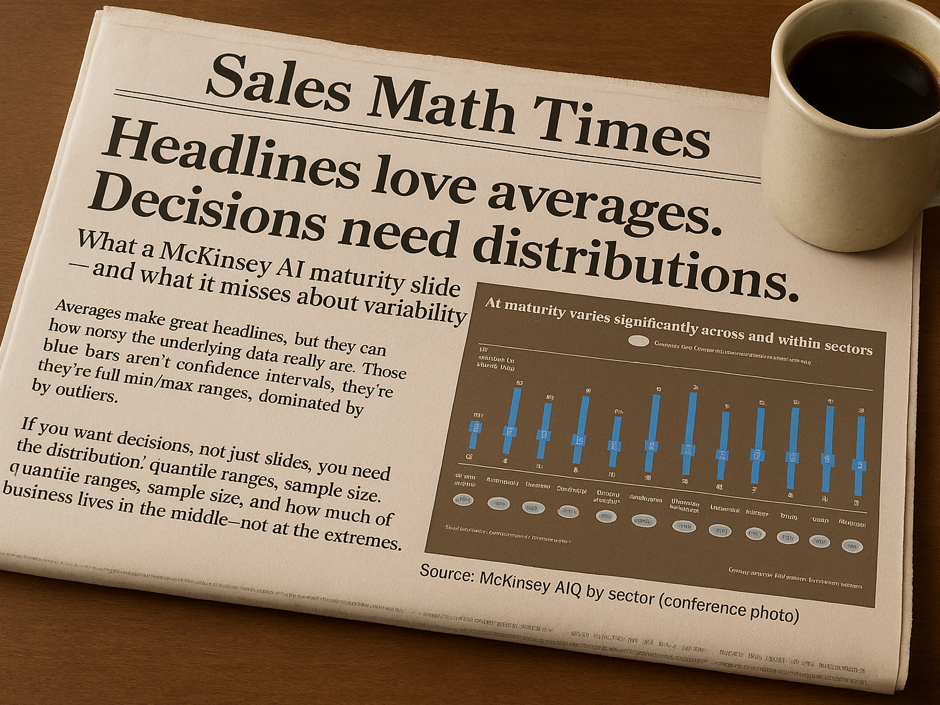Forecast Category – License to Shill
- Bill Kantor
- Aug 2
- 3 min read
Updated: Aug 5
The traditional sales forecasting playbook:
Reps categorize each deal — Commit, Best Case, Pipeline, Omitted.
Managers roll them up, then make up their own numbers.
CRO does the same.
You get a made up number, informed by made up numbers, informed by opinions.
This is what most sales orgs do. It feels useful, but as we’ve written in Forecast Category Considered Harmful, it’s myopic, inaccurate, and suboptimal. A ritual that takes time and rarely improves decisions or outcomes.

And sometimes, it creates confusion, or maybe delivers bad news. As in this real example:
Close date is in the current quarter.
Stage is one before Closed Won.
Forecast Category is… Omitted?
What do you make of that?
What is Forecast Category adding that stage and close date can’t already convey? In this case, Forecast Category is clouding the forecast.
If the salesperson wants the deal excluded from the forecast rollup, why not just push the close date out of the quarter? (Any time in a future quarter—you can refine this as you learn more.) Or push the stage back. Are they trying to communicate some subtle nuance?
Maybe:
“It's in the last stage, we’ll either win or lose this deal this quarter.”
Or, more likely:
“The cat’s on the roof” — a gentle way of breaking bad news.[1]
The nuance doesn't matter. Forecast Category here contradicts stage and close date. It's confusing.
This is one of many reasons to retire Forecast Category. It is a license to shill:
Dress up opinions as insight.
Brand weak deals as "Commit."
Bury bad news as "Omitted" or "Pipeline."

Admittedly, Commit is usually a strong "win" signal. But it overlaps with stage. So the signal is smeared out over the two highly correlated fields.[2] Except in some cases, like the one above, where one signal is stronger than the other. But you never quite know which.
The result? Each field weakens the other. Highly correlated variables undermine predictive models—leading to erratic predictions, wider confidence intervals, reduced statistical significance, and difficulty interpreting results.[3]
Worse, the potential ambiguity turns Forecast Category into forecasting theater.[4] It gives people the freedom to spin a narrative. A plausible excuse when a deal doesn’t behave as the stage/close date implied. On one hand you are saying it's going to close this quarter. On the other, you are saying it isn't. One of them is bound to be right!
You can tighten the definitions of Forecast Categories to make them more meaningful. But isn't that what sales stages are for? If you want more rigor, why not enforce it there?
And if it’s accountability you’re after—consider this: Is it acceptable if someone commits Deal A, misses it, but brings in Deals B and C instead, for the same total value? Most would say yes. That means you're interested in total sales, not named deals. There are far better ways to get realistic Commit and Best Case figures. Book a meeting to see how you can do that with no additional work.
It's time to move on. Forecasting should reveal the realistic truth—not provide cover to obscure it. Replace Forecast Category rollups with a more realistic forecast that shows you how to sell more.
Want to learn more?
[1] It's a classic joke in my family. Here's a good version. Brazilians have a similar cultural phrase: “A vaca foi pro brejo” — “The cow went to the swamp.” It means things have gone irreparably wrong. I learned this at a cocktail party in Rio de Janeiro, after telling “the cat's on the roof” joke. The Brazilians already knew the punchline. (They politely laughed.)
[2] Three if you also are manually setting probability.
[3] So pick one. You could use Forecast Category. It's a little limiting compared to stage, but some businesses do this.
[4] The default behavior in Salesforce maps Forecast Categories to groups of sales stages. This is harmless but adds no value—you could easily summarize by sales stages. The "theater" problem arises when you allow reps to override the auto-mapping.




Comments